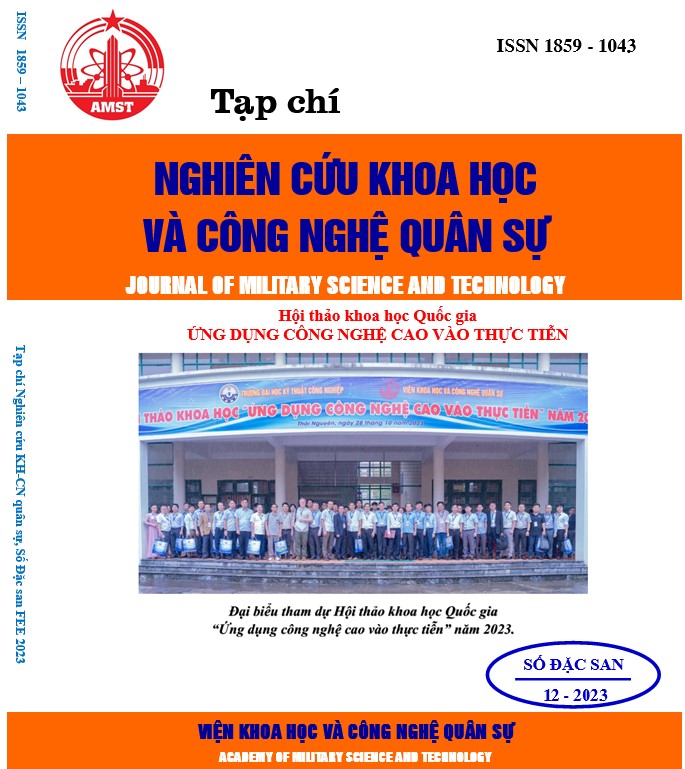Studying the heat resistance of hydrophilic-hydrophobic polymer used in enhancing oil recovery
543 viewsDOI:
https://doi.org/10.54939/1859-1043.j.mst.FEE.2023.251-255Keywords:
Polymer injection technology; Polyacrylamide; Hydrophilic - hydrophobic polymer; Heat resistant; EOR.Abstract
Hydrophobically associating polyacrylamide (HAP) polymers differ from traditional water-soluble polymers (hydrolysis polyacrylamides (HPAM) in that they are partially composed of hydrophobic monomers on the HAP chain, which are capable of forming physical bond in the form of micelles in aqueous solution. This structure imparts distinct rheological and adsorption properties to HAP, making them outstanding in enhanced oil recovery (EOR) applications. Experimental results indicate that, at low concentrations, the hydrophilic-hydrophobic polymer solution significantly improves oil recovery, with more stable profile shifts and better scanning efficiency than conventional polymers at the same concentration. The main attractions of these hydrophilic polymers are their ability to significantly increase viscosity compared to conventional polymers and their ability to maintain viscosity under high-temperature operating conditions. In this paper, the authors investigated the thermal stability (heat resistance) of the hydrophilic-hydrophobic polymer through the property of the viscosity of the solution when tested at high temperatures, thereby confirming the ability to use polymers synthesized in the laboratory of the Institute of Chemistry-Materials, the Military Academy of Science and Technology in injection technology to enhance oil recovery in the condition of the lower Miocene formation of oil fields on the continental shelf of Vietnam.
References
[1]. Phùng Đình Thực. “Một số giải pháp công nghệ và kỹ thuật góp phần nâng cao sản lượng giếng dầu và hệ số thu hồi dầu mỏ Bạch Hổ”. Hội thảo: Nâng cao hệ số thu hồi dầu mỏ Bạch Hổ., Tập đoàn Dầu khí Việt Nam, (2002).
[2]. Nguyễn Hữu Trung và cộng sự, “Nghiên cứu khả năng ứng dụng phức hệ Polyme để bơm ép trong móng nứt nẻ tại các giếng khoan ở thềm lục địa Việt Nam nhằm nâng cao hệ số thu hồi dầu khí”, Viện Dầu khí Việt Nam, số 5, (1996).
[3]. Phạm Trường Giang, Trần Đình Kiên, Hoàng Linh, Đinh Đức Huy, Trần Xuân Quý, Phan Vũ Anh, Phạm Chí Đức, Lê Thế Hùng, Phạm Văn Tú, Trần Đăng Tú, Vương Việt Nga và Lưu Đình Tùng, “Đánh giá khả năng và xây dựng kế hoạch thử nghiệm bơm ép polymer cho tầng Miocene dưới mỏ Bạch Hổ nhằm nâng cao hệ số thu hồi dầu”, Tạp chí Dầu khí, Số 8, trang 44 - 52, (2018).
[4]. Akstinat, M.H “Polymers for enhanced oil recovery in reservoirs of extremely high salinities and high temperatures”. Paper SPE 8979 presented at the SPE Fifth International Symposium on Oilfield and Geothermal Chemistry, Stanford, 28–30, (1980). DOI: 10.1016/j.egyr.2020.11.247. DOI: https://doi.org/10.2118/8979-MS
[5]. Chen, H., Zhang, S.H., Chu, Y.B., Yang, H.X., Liu, F.L. “Development and application of hydrophobically associating polymer gel in high-temperature and high-salinity reservoirs for profile modification”. Oilfield Chemistry Vol. 21 (4), 343–346, (2004).
[6]. Tan H, Tam KC, Tirtaatmadja V, Jenkins RD, Bassett DR. “Extensional properties of model hydrophobically modified alkali-soluble associative (HASE) polymer solutions”. J Nonnewton Fluid Mech; 92(2–3):167–85, (2000). https://doi.org/10.1016/S0377-0257(00)00093-8. DOI: https://doi.org/10.1016/S0377-0257(00)00093-8
[7]. Abdala AA. “Solution rheology & microstructure of associative polymers”. Doctoral Dissertation Raleigh (USA): North Carolina State University; Vol. 6, (2002).
[8]. Tan H, Tam KC, Jenkins RD, “Rheological properties of semidilute hydrophobically modified alkali-soluble emulsion polymers in sodium dodecyl sulfate and salt solutions”, Langmuir Vol. 3, 16(13):5600–6, (2000). https://doi.org/10.1021/la991691. DOI: https://doi.org/10.1021/la991691j







